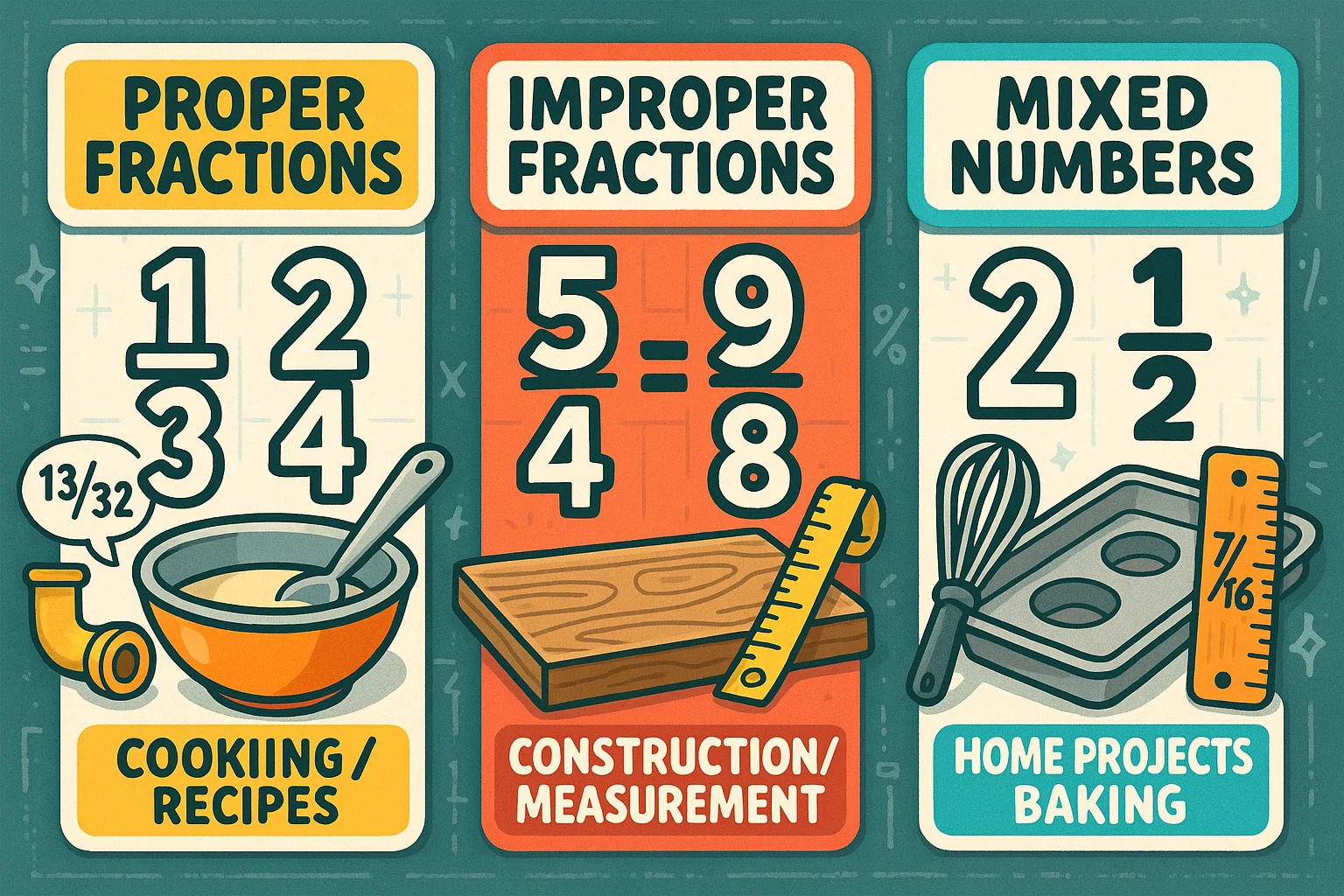Fractions pop up everywhere — in recipes, construction plans, school math problems, even when you’re figuring out how to split a dinner bill. But they’re not always easy to work with, especially when you need to switch them into decimals, percentages, or simpler terms. A fraction like 5/8 might make sense on a ruler, but not when you’re trying to calculate interest or balance a budget. That’s where fraction conversions make life easier, helping you move between different forms so calculations stay quick, clear, and accurate.
If you need to quickly switch between fractions, decimals, or percentages as you read, try our Conversion Tools for fast, accurate results
Types of Fractions You’ll Encounter
Fractions aren’t all the same — some are simple and familiar, while others can feel awkward or confusing. Here are the main types you’ll come across and where they’re often used:
-
Proper fractions – These have a numerator (top number) smaller than the denominator (bottom number), like 1/2 or 3/4. You’ll see them most often in recipes or basic measurements because they’re easy to visualize.
-
Improper fractions – Here, the numerator is equal to or larger than the denominator, like 5/4 or 9/8. These often show up in math problems or construction when measurements extend past a whole number.
-
Mixed numbers – A whole number paired with a fraction, such as 2 1/2. These are common in cooking, baking, and home projects, where instructions need to be clear but still precise.
Some fractions are instantly familiar — 1/2, 1/3, 3/4 — while others like 7/16 or 13/32 can be tricky. Those smaller divisions are common in carpentry, plumbing, and manufacturing, where materials like pipes and boards are measured down to the nearest sixteenth or thirty-second of an inch.

Converting Fractions to Decimals and Percentages
Switching a fraction into a decimal or percentage can make calculations much easier — especially for things like budgeting, measuring materials, or comparing values. The process is straightforward: divide the numerator (top number) by the denominator (bottom number).
For example:
-
1/2 = 0.5 (decimal) = 50%
-
3/4 = 0.75 (decimal) = 75%
-
5/8 = 0.625 (decimal) = 62.5%
Some fractions turn into clean decimals that end after a few places, like 1/4 (0.25). Others create repeating decimals, such as 1/3 (0.333…). In most practical cases, these repeating decimals get rounded to two or three places for easier use — for example, 0.333 becomes 0.33, or 33%, when working with money or measurements.
Decimals are often preferred in fields like engineering, science, and finance, where precision to multiple decimal places is essential. Percentages, on the other hand, are more useful when comparing parts of a whole, such as discounts, taxes, or performance metrics.
Quick Tip: “The fraction 22/7 is commonly used as a quick stand-in for π (pi). It’s close, but not perfect — it’s off by about 0.04%, which can add up in large-scale calculations like construction or astronomy.”
Turning Decimals Back Into Fractions
Sometimes it’s easier to work with a fraction instead of a decimal, especially in cooking, construction, or any situation where measurements are marked in fractions on tools like rulers. Converting a decimal back into a fraction can be done in a few simple steps:
-
Identify the decimal – For example, 0.75.
-
Count the decimal places – 0.75 has two decimal places, so the denominator will start as 100 (for two places).
-
Turn it into a fraction – 0.75 becomes 75/100.
-
Simplify to the lowest terms – Divide numerator and denominator by their greatest common factor (25) to get 3/4.
For repeating decimals like 0.333…, the easiest approach is to recognize common patterns:
-
0.333… equals 1/3.
-
0.666… equals 2/3.
-
0.142857… equals 1/7 (a repeating cycle often used in advanced math and finance).
In most real-world situations, you don’t need to convert perfectly. For instance, if you’re cooking and need to approximate 0.33 cups of sugar, using 1/3 cup is perfectly acceptable.
Adding, Subtracting, and Comparing Fractions
Working with multiple fractions can feel messy, but it gets easier once you know the shortcuts. The key is to make sure all fractions speak the same “language” — in other words, they share a common denominator.
Finding a Common Denominator
To add or subtract fractions, the denominators (bottom numbers) must match. If they don’t, multiply each fraction by whatever factor is needed to create a shared denominator. For example:
-
To add 1/4 + 1/6, the lowest common denominator is 12.
-
1/4 becomes 3/12, and 1/6 becomes 2/12.
-
3/12 + 2/12 = 5/12.
This same principle applies when comparing fractions. To see whether 3/5 is larger than 5/8, convert both to a common denominator or quickly turn them into decimals (0.6 vs. 0.625).
Simplifying Fractions
Once you’ve added, subtracted, or compared any fractional percentages, it's time to tidy things up. That means simplifying. To do this, divide both the numerator and the denominator by their greatest common divisor (GCD). It's the largest number that evenly divides into both parts of the fraction.
Take this example:8⁄12 simplifies to 2⁄3, because both 8 and 12 can be divided by 4.
Here’s the math in steps:8 ÷ 4 = 2 and 12 ÷ 4 = 3 → So 8⁄12 = 2⁄3
A quick rule of thumb? If both numbers are even, start dividing by 2 and work up until nothing else goes in cleanly. If you're not sure, a Math Calculator or a built-in GCD function in most spreadsheets (like =GCD(8,12)) does the heavy lifting.
🔍 Quick tip: A simplified fraction not only looks cleaner, it’s often easier to convert into a percentage or decimal. That’s a win in any equation.

